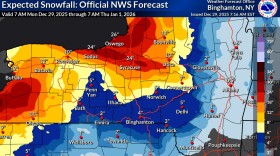The SUNY College of Environmental Science and Forestry in Syracuse has come out with a top ten list of new species discovered in the last year. SUNY ESF President Quentin Wheeler says the list is culled from the 18,000 new plants and animals scientists discover every year.
Wheeler says it’s not just plants or animals on the list. There’s a 600-pound chicken-like dinosaur that researchers used to think was a bird, nicknamed the “chicken from hell” because they hung out in nests of dinosaur eggs.
 Life reconstruction of the new feathered dinosaur species Anzu wyliei in its approximately 66 million year-old environment in western North America.
Life reconstruction of the new feathered dinosaur species Anzu wyliei in its approximately 66 million year-old environment in western North America.
Credit Mark A. Klingler, Carnegie Museum of Natural History / International Institute of Species Exploration, SUNY College of Environmental Science and Forestry
“And so for many years, it was thought they were small predators, running around eating dinosaurs eggs. More recent evidence suggests that they themselves were egg layers, and sat on a nest like birds,” said Wheeler.
Some of the new species have been around all along, just not documented. Like the red and green Bromeliad plant in Mexico that’s been used during Christmas festivals for years.
"It’s very festive and gorgeous, well known to many villages and villagers in Mexico, entirely new to science.”

There are new species of insects, like a spider from Africa that escapes danger by turning into a kind of gymnast.
"If it’s feeling really threatened, it will start doing cartwheels, and it spins on its side like a wheel, towards the perceived threat,” said Wheeler.
And there’s the Bone-house wasp, the first species known to create a toxic entrance to the chambers containing her offspring.
"Predators or parasites that try to get to her babies, first are encountered by this big pile of dead ants. And the ants are just filled with noxious chemicals.”
Some of these new species are already endangered, like a parasitic coral plant that shoots out tubers that draw nutrition from other plants.
“The best evidence so far, is that it only occurs in one small area of the Philippines -- it’s not in a protected area -- and there may be as few as 50 living plants.”
And while scientists are discovering thousands of new species like this every year, they’re also watching just as many going extinct. So for Wheeler, scientists must continue to explore what he calls the last vast unexplored frontier on Earth, the biosphere, which supports living organisms.
"Keep in mind that we only know fewer than two million species out of what we think are 12 million living species, so until we know what is there to begin with, it’s very hard to precise, knowing exactly what we’re losing.”








